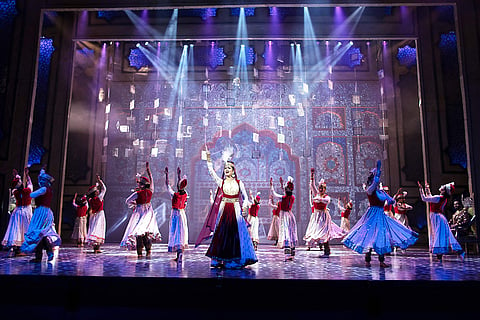
- LIFESTYLE
- FASHION
- FOOD
- ENTERTAINMENT
- EVENTS
- CULTURE
- VIDEOS
- WEB STORIES
- GALLERIES
- GADGETS
- CAR & BIKE
- SOCIETY
- TRAVEL
- NORTH EAST
- INDULGE CONNECT

The reason why people keep seeing classics again and again is because they continue to connect with its characters even after several years. Mughal-E-Azam an award winning musical directed by theater director Feroz Abbas Khan is one such saga of emotions, having multiple shows season after season since its inception in 2016. After a successful run of 19 seasons, India’s most expensive musical production is making its way to the United States. It will debut in Atlanta on May 26th, and subsequently tour 13 cities across North America. The show will be performed at various venues, including the renowned Lincoln Centre for the Performing Arts in New York.
For those unversed of its magnanimity, the show has won seven awards at the prestigious The Broadway World India Awards 2017. Feroz Abbas Khan received the Best Director Award, while renowned fashion designer Manish Malhotra who has done over 600 costumes for the show was honoured with Best Original Costume Design. Mayuri Upadhya's choreography earned her the award for Best Original Choreography, and Neil Patel's set design was recognised as the Best Original Set Design. Its previous runs in India had veterans like actresses Rekha and Hema Malini, as well as directors Karan Johar, Ashutosh Gowariker, and Gurinder Chadha as its spectators. Now as creative mavens in theatre, dance, music, costumes and production come together to bring this show abroad for the first time, we speak to them on what went into the making of this spectacle.
How is your theatrical production different from the 1960 hit film?
Feroz Abbas Khan: K Asif's production had sprawling sets, most notably that of Sheesh Mahal, which was created with actual Belgian mirrors. The film had jaw-dropping and realistic war scenes which were achieved without any special effects and fabulous costumes encrusted with real jewels. Ours is a stage production and so the properties we use for set design and to suggest the architectural elements and the costumes that the artistes wear have to suit the dynamics of a live performance. We are not trying to replicate the film but referring to it with modified design elements while conveying its musical and artistic depth.
What tech innovation and soundscapes have been used to add a contemporary touch?
Feroz Abbas Khan: The sound and lighting play a big part in any production and especially in a dynamic musical where we stage over 50 scenes to show the progression of the story. The technology is unobtrusive but it is used to make this progression look seamless. It's used to keep the focus of the audience on how it celebrates India’s syncretic culture and the beauty of its arts, crafts and architecture.
Manish, what was the brief given to you for costume design? Tell us the sartorial elements you incorporated in costumes.
Mughal-e-Azam is very close to my heart. It was the first time, I was doing a period drama comprising 600 costumes! We did our recce around plays and theatre costumes as I had to modify the structure of designs from my normal runway fare where the linings used in the outfits for the artists were much lighter. For the production, the designs had to speak of grandeur, glory and the extravagance of the Mughal period. The costumes had to be stage appropriate and facilitate a quick change. It is a period piece but done with modern sensibilities. So the designs carry forward the legacy of the original characters as well as signature sheen to illuminate its grandiosity. Each ensemble, layered with garments from kurta to Sherwani, was meticulously planned to ensure swift changes. The fabrics used were a showcase of vintage richness featuring everything from silk and kota to zardousi embroidery, brocades, bandini and velvet.
Mayuri, tell us how Sufi gharanas of Kathak were used as a tool to bring the nazaakat of regal era?
As a choreographer, I had to travel back in time to visualise the regality of Mughal era and then translate it onto stage. Luckily, dance as an art form is expressive and a powerful medium, which can create a collective experience without words. It enhances and heightens any given emotion, which helps the storytelling. While choreographing, there is a common overall intent and framework first and within that each composition develops its unique flavour. The context, scene, character, mood all these become part of the process.To hold the attention span of the live audience from the frontal view of a proscenium stage without any camera angles, multiple takes, close ups is a huge challenge. So, my exploration came with a defined border: to be as authentic as possible, to approach the classical Kathak from Lucknow and Jaipur gharanas in a contemporary way without messing it with the original form and without fusing it with a lot of filmy movements. Without a set formula to choreography, simple instincts, ideas, metaphors, emotional moments sparked my process of creation.
In Atlanta. May 26 onwards.
Email: priyamvada@newindianexpress.com
Twitter: @ranapriyamvada